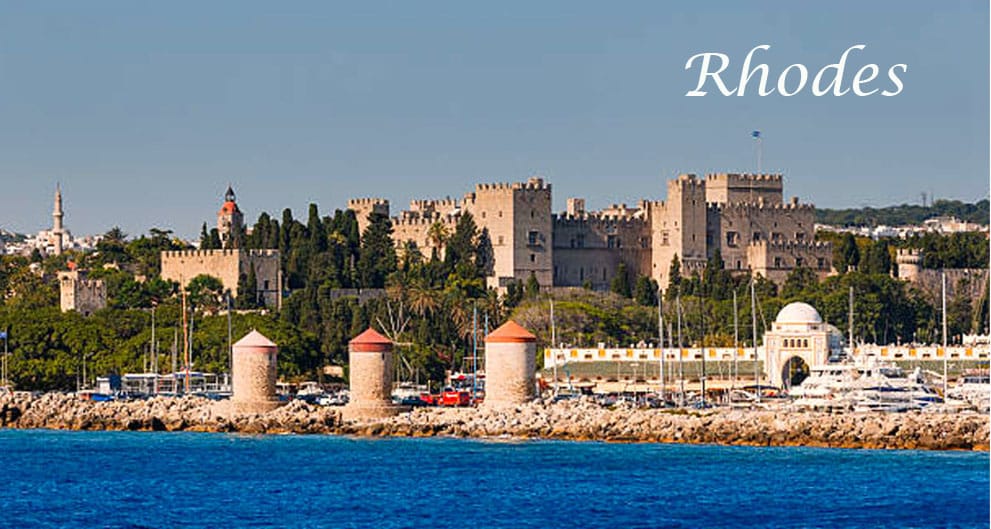Information about the island of Rhodes, Greece
Introduction
Rhodes is one of the Greek Dodecanese Islands located in the Aegean Sea 250 kilometres south east of the mainland port of Piraeus. It’s the biggest and busiest island in the archipelago and its notorious holiday resort Faliraki has been the focus of much media attention due to the drunken excesses of young visitors (mostly the British variety). But there’s so much more to Rhodes than the wild beach parties and Eurovision “Thong Contests” so highly publicised in the British press.
This is an island steeped in history with some fascinating ancient sites and a stunningly beautiful capital, Rhodes Town, which is the oldest inhabited medieval town in Europe. Hire a car to explore the hinterland behind infamous Faliraki and you’ll find unspoilt mountain villages, isolated hill top monasteries and rich fertile plains.
The island is actually much closer to Asia Minor than mainland Greece – it’s just south of the Turkish port of Marmaris which is an easy day trip by excursion boat. Its location at the crossroads between east and west has made the island a prime target for various invaders over the centuries. Rhodes bears many legacies and battle scars left by those who have sought to control it since the first settlers arrived here more than 3,000 years ago. The Romans, Turks and Italians have all made their mark here but it was the Order of the Knights of St John which had the greatest impact on the capital, Rhodes Town. Visit the old town today to marvel at its remarkably well preserved medieval citadel dominated by the magnificent Palace of the Grand Masters.
The Knights of St John were originally a holy order whose mission was to tend Christian pilgrims in Jerusalem. They later became a military order and established a base on Rhodes after “buying” the island from the Genoese pirate Admiral Vignoli in 1306. They ruled here for more than 200 years before being ousted by the Turks.
A visit to the impressive fortress, which was the seat of 19 Grand Masters, has got to be on the top of your “must see” list. But beyond its walls you’ll find a bustling modern town with one of the liveliest night scenes in Greece and a major sea port serving not only Athens, Crete and the Aegean islands but also Turkey, Cyprus and Israel.
One of the island’s greatest claims to fame has tragically disappeared (and in fact may not ever have existed!). The Colossus of Rhodes was reputedly built astride the harbour of Mandraki in 305 BC. The bronze statue of the island’s sun god Helios stood 32 metres high and took 12 years to build.
It was toppled by an earthquake in 225 AD and lay undisturbed for more than 800 years in accordance with a pronouncement from the Oracle at Delphi (where the high priestess issued various utterances on behalf of the god Apollo). In 654 AD it was apparently carted off to Syria by more than 900 camels to be sold as scrap metal.
The east coast of the island is peppered with lovely beaches many of which remain uncrowded and relatively unspoilt compared with frantic Faliraki.
The island has an international airport at Paradisi 16 kilometres west of the town. There are regular Olympic Airways flights to and from Athens, plentiful cheap charter flights connecting the island with several UK airports and services to many European capitals.
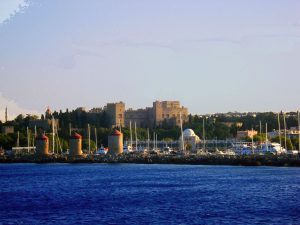
From awe-inspiring archaeological sites and medieval landmarks to myriad beaches, nature excursions, water sports, and shopping – Rhodes promises memorable experiences. Not to forget its delectable cuisine that embodies traditional flavours.
The Old Town, encircled by grand walls, castles, palaces, and intricate cobblestone streets, forms the heart of Rhodes’ medieval city. This city, remarkably well-preserved, ranks among the world’s most captivating medieval urban centres.
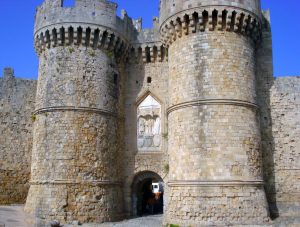
Throughout the city, the tales, legends, and traditions of the Knights of St. John come to life, bearing witness to their indelible imprint on the island’s history and cultural tapestry.
The harmonious blend of Byzantine, Ottoman, and Jewish monuments attests to Rhodes’ multicultural legacy, continually captivating visitors.
Walking along the Street of the Knights, the medieval city’s most renowned thoroughfare, various landmarks unveil their stories. From the Byzantine Church of Our Lady of the Castle to the Clock Tower, from the pink-hued Mosque of Suleiman with its commanding minaret to the Jewish Synagogue at the heart of Rhodes’ Jewish quarter, every corner divulges a piece of the island’s intricate history.
The Grand Master’s Palace stands out with its majestic architecture and invaluable artefacts, promising to enthral every observer. Additionally, the iconic deer statues grace the harbour of Rhodes, and a short distance to the north, visitors can relish the serene Butterfly Valley.
Numerous attractions cement Rhodes’ status as a premier destination not only in Greece but also globally. A journey across the island reveals idyllic villages, scenic vistas, mesmerising beaches, and historic landmarks.
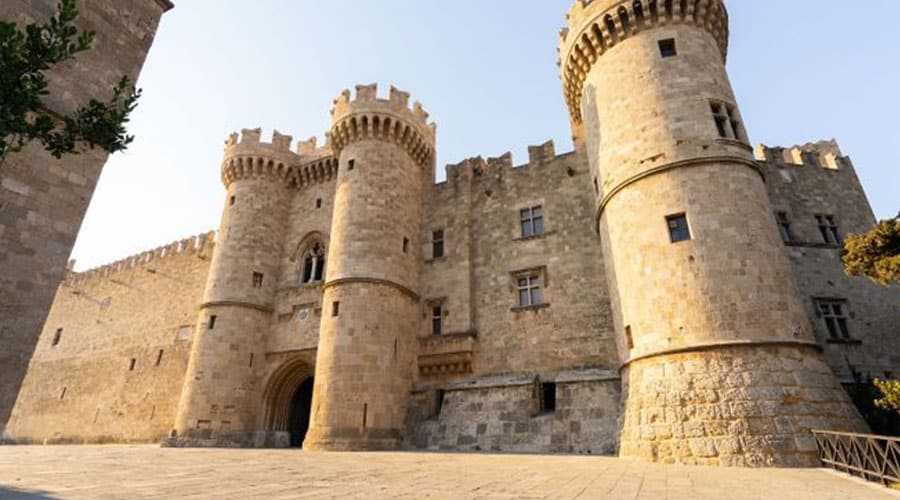
With golden sandy shores, multicoloured pebbles, quaint bays, nooks along the coastline, and the island’s verdant flora, Rhodes paints a picture of a terrestrial paradise, ensuring every visitor cherishes unforgettable moments.
Popular and cosmopolitan, with the old town and fairytale castles, beaches and clear blue waters, beautiful and picturesque villages. Rhodes, although it hosted one of the seven wonders of the ancient world, is also a small wonder in itself.
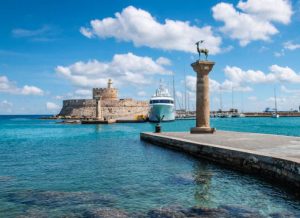
On the island that literally has it all and is the fourth largest in Greece, you will see the harmonious coexistence of the modern city with the castle, the monuments of antiquity with the medieval buildings and the new city with modern shops, modern buildings and the big hotels satisfy every visitor.
Rhodes offers a wealth of options for all tastes and ages and depending on what you prefer, you will have a calm or intense holiday, as you will enjoy its endless sandy beaches, stay in hotels that will host you like royalty, visit the spectacular archaeological and medieval monuments, you will indulge in nature activities, water sports, walks and shopping, while tasting good food and traditional flavors. Just make sure you have several days at your disposal to uncover all her faces.
The city of Podos is divided into two large parts, the new city, outside the walls, and the old city, inside the walls. The new city is located on the north-eastern side and stretches up to the hill of Agios Stefanos, where important archaeological findings were discovered.
Of course, you will visit the old town of Rhodes, which was declared a UNESCO World Heritage Site. You will see the city walls, the medieval moat and the cobbled Knights’ Way, as well as the stag pillars, where the Colossus of Rhodes is said to have rested in ancient times.
Pass by the palace of the Grand Master, the Archaeological Museum of Rhodes housed in the monumental medieval building of the Hospital of the Knights, the ancient Acropolis of Lindos, the archaeological site of the Necropolis of Korakoneros and the pier of the mills.
The modern city has an excellent layout and infrastructure, with wide streets, parks, two ports, wonderful neoclassical and older buildings with the stamp of the Turkish and Venetian eras. The traffic in the streets is heavy, but the noise of the city stops at the passage of the great gate of the castle.
Here, the traffic of cars is prohibited in most places and the tour of the narrow cobbled streets, among the medieval buildings – the only ones in the world that are inhabited to this day –, the castle of the Knights and the cobbled squares will enchant you.
You will see them on tree trunks sleeping during the day, where they will spend the entire summer. If you are lucky you may see a magnificent cloud of butterflies flying and courting the trees, rare beggars and countless plants, among small streams and ponds of water lilies.
You can see the Museum of Natural History, walk through the valley, climb the bridges and reach the monastery of Kalopetra built in 1784. But it needs attention, as the butterflies sleep during the day and it is important not to disturb them.
The beaches of Rhodes are considered among the best in Greece and most of them are located on the east and south coast of the island. Secluded and quiet or well organized and crowded, they will all charm you with their beauty.
Rhodes in Mythology

However, the Sun intervened, seeing a new land emerging from the sea. The Sun requested this emerging territory for itself. Zeus then summoned Lachesis to vow that this newfound land would belong to the Sun. Thus, the beautiful island emerged from the sea’s foam and was granted to the Sun God.
On this island, the Sun and the Nymph Rhodes had seven sons, known as the Heliades: Ochimos, Cercaphos, Macar, Actis, Tenages, Triopas, and Candalos, along with a daughter named Electryone. Cercaphos fathered three sons, namely Camiros, Ialysos, and Lindos. They divided the island into three parts, each establishing a city named after himself.
This myth, born from the people’s imagination, tries to interpret various events. The rise of Rhodes from the sea is related to geological theories of the Earth’s surface formations, such as uplifting and subsiding. The Sun’s affection for Rhodes is explained by the almost perpetual sunshine the island enjoys throughout the year. Thus, Rhodes was named the “Nymph of the Sun” and is considered a daughter of Aphrodite, who emerged from the sea’s foam.
History
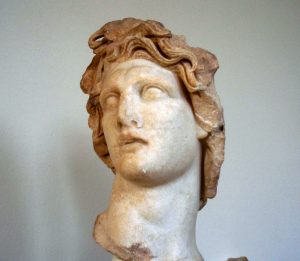
Medieval Period: The Knights Hospitaller, or the Knights of St. John, are perhaps the most iconic chapter in Rhodes’ history. They occupied the island in 1309 and transformed the city into a fortified stronghold. Under their rule, the island flourished as a bastion of Christendom against the Ottoman Turks.
The Ottomans eventually seized Rhodes in 1522 after a protracted siege. The island remained under Ottoman control for nearly four centuries until Italy captured it during the Italo-Turkish War in 1912. Italian rule introduced architectural and infrastructural developments to the island.
Following World War II, Rhodes, along with the rest of the Dodecanese, was transferred to Greece in 1947. Today, it’s a blend of its ancient, medieval, and modern heritage, attracting visitors worldwide.
People and Culture
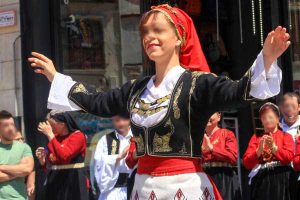
Rhodian culture is a captivating blend of influences from various civilizations that have left their mark on the island throughout history. The ancient Greeks, Romans, Byzantines, Knights of St. John, Ottomans, and Italians have all contributed to the unique cultural mosaic of Rhodes. This diversity is evident in the island’s architecture, cuisine, and traditions.
The locals take pride in preserving their cultural heritage, and this is reflected in the well-preserved medieval Old Town of Rhodes, a UNESCO World Heritage Site. The narrow cobblestone streets, medieval architecture, and historic landmarks such as the Palace of the Grand Master showcase the island’s rich history.
Traditional music and dance are integral parts of Rhodian culture. Local festivals and celebrations often feature traditional music with instruments like the lyre and the lute, accompanied by lively dances that echo the island’s folk traditions. These cultural expressions provide a window into the soul of Rhodes and its people.
The people of Rhodes celebrate various festivals and events throughout the year, each rooted in religious or cultural traditions. Easter is a particularly significant celebration, marked by religious processions, church services, and festive gatherings.
In recent times, tourism has become a crucial part of the local economy, and the Rhodians welcome visitors with open arms. The island’s cultural richness, combined with the hospitality of its people, makes Rhodes not just a historical destination but a living, breathing testament to the enduring spirit of its inhabitants.
Traditional Cuisine of Rhodes
The cuisine of Rhodes is a delicious reflection of its history and geographical location. Influences from Greek, Turkish, and Italian cuisines can be found in the local dishes. Fresh seafood, olives, olive oil, vegetables, and a variety of cheeses are staples of Rhodian gastronomy.
Indulge in the flavors of Rhodes, Greece with its traditional cuisine that reflects a rich culinary heritage. Fresh seafood dishes like grilled octopus and stuffed squid are popular choices among locals and tourists alike. Savor the taste of Moussaka, a classic Greek dish made with layers of eggplant, minced meat, and creamy béchamel sauce. Pair it with a side of Greek salad topped with feta cheese and olives for a refreshing combination.
Don’t miss out on trying Souvlaki, skewers of grilled meat served with pita bread and tzatziki sauce. For dessert, treat yourself to a slice of Baklava, a sweet pastry made with layers of phyllo dough filled with nuts and honey. Experience the true essence of Rhodes through its authentic dishes prepared using locally sourced ingredients that capture the essence of Mediterranean cuisine.
Sights and attractions of Rhodes
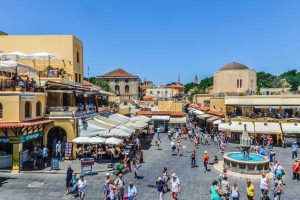
In the heart of the Old Town, the Museum of Rhodes at the Hospital of the Knights delves into the multifaceted history of the Knights, exploring their military endeavors and hospital activities. The Folklore Museum of Rhodes, also nestled within the Old Town, immerses visitors in the island’s cultural heritage through displays of traditional costumes, furniture, and crafts. For those interested in the island’s Jewish history, the Rhodes Jewish Museum provides insights into the medieval Jewish community.
On the archaeological front, Ancient Kamiros offers a captivating journey through time with its well-preserved ruins, including mosaics, temples, and public buildings. The Lindos Acropolis, overlooking the town of Lindos, boasts ancient structures such as the Doric Temple of Athena Lindia. Further explorations lead to Ancient Ialysos, an archaeological site featuring a temple and stadium, and Ancient Kameiros, showcasing remnants of a Hellenistic temple, agora, and residential structures.
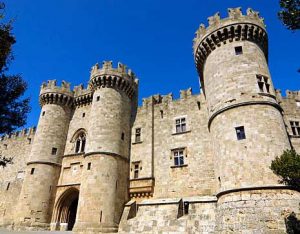
These sites represent just a fraction of Rhodes’ cultural and historical treasures, inviting visitors to explore the island’s rich tapestry of the past. Whether wandering through ancient ruins, perusing museums, or marveling at medieval architecture, Rhodes promises an immersive journey through time and heritage.
Rhodes, the historical capital of the Dodecanese, is a whole chapter in itself. The Medieval town, the castles, the ancient treasures, the nature, the beaches, the accommodation, the food, rank it as one of those islands that have it all. Rhodes is one of the most well-preserved medieval cities and has been designated as a UNESCO World Heritage Site, while it was known since ancient times as the city of the Colossus of Rhodes, which was one of the Seven Wonders of the Ancient World.
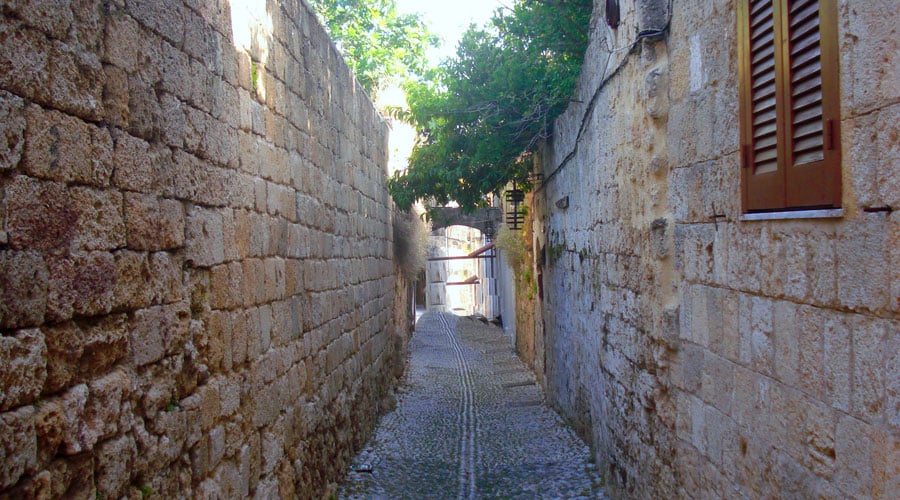
The Knights of the Order of Saint John, the Ottomans and the Italian conquerors who left an indelible mark and in general the glorious history is perceived from the very first minute one arrives in the city. A city that could be characterized as a bridge between the present and the past, since it very successfully combines the medieval tradition and the memories of an, if nothing else, glorious past with modern development and the intense rhythms of everyday life.
History buffs flock to the magnificent Acropolis of Lindos and the Cycladic-style village of Lindos. Adventurers head inland for hiking and mountain biking, and south to Prasonisi for kitesurfing and windsurfing. Cosmopolitans choose the northern half of the island, which is also the most developed for tourism and where most hotels are located, including multiple all-inclusive options. New, luxury resorts are springing up along the southeast coast.
As for the beaches that concern everyone, they are enchanting in the majority of them. Deserted or cosmopolitan, vast or small, with golden sands or white pebbles, organized or unspoiled, they make up an endless list that has something for all tastes – even the most demanding. In any case, in one weekend, apart from the beaches, you manage to see and do a lot!
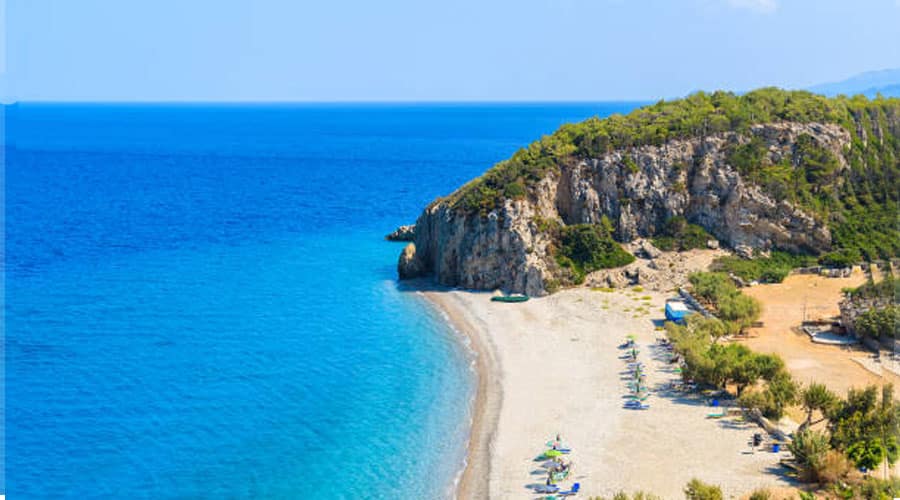
A car is essential in Rhodes, not only to easily reach the many attractions and beaches, but also to admire the green landscapes that alternate between seascapes and soaring mountain peaks. However, if you choose the city center for your stay, you don’t need the car in the morning hours, only at noon and in the evening for your transport to the beach and your night out.
Stroll around the alleys in the Old Town of Rhodes
The Palace of the Grand Master of the Knights is located on the north-west side of the medieval city of Rhodes at the highest point of the castle and is perhaps the most important monument of the period of the knights.
Strolling around the old town of Rhodes you will learn, among other things, the real history of the Colossus, whose traces are lost somewhere between myth and legend, you will see the famous Deer of Rhodes, you will admire the unique architectural complex of buildings from the fascist period and you will be informed first hand for their everyday life residents of the modern city, as the commercial center of Rhodes stretches around.
You might as well go to the Medieval City to travel back to Knightly times. The Great Knights Hospital, the imposing Palace of the Grand Master, the Mosque of Suleiman the Magnificent, the central Hippocrates Square, the Jewish Martyrs Square, are the main stations you will see on your way.
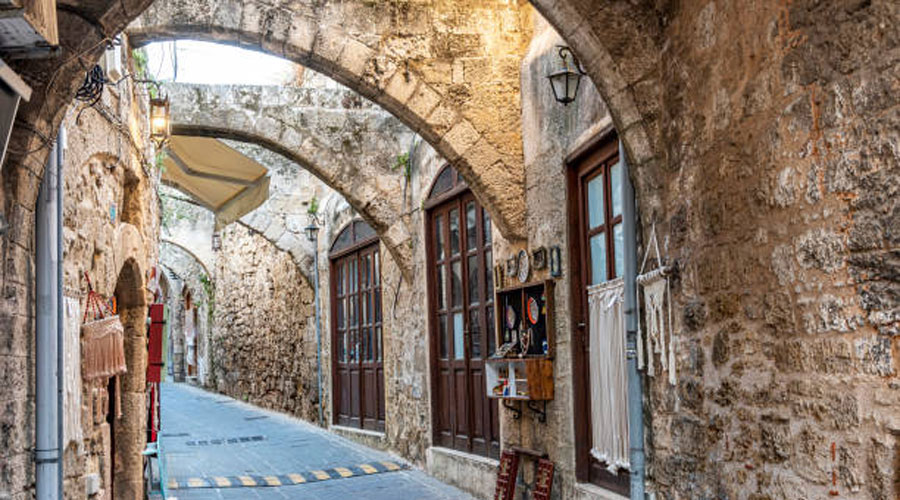
Go to the springs of Kallithea
Get up early and start your day with a coffee in Kallithea, which is only 9 km from Rhodes Town. Wander the mosaic paths through the public baths built by the Italians in 1929 and renovated a few years ago. The unparalleled monumental architecture and magnificence of the space, with the unique mosaics, the Rotunda room where the thermal waters once gushed, the Atrium and every corner of the Kallithea Springs will refer you nostalgically to another era.
The springs of Kallithea are an organized tourist area with a beach and umbrellas, but this beautiful building by the Italian Petrio Lombardi was characterized as one of the best of that time and of course you must spend some of your time there. It is also worth noting that you will be reminded of Roger Moore and Telly Savalas as scenes from the popular movie “Escape to Athena” were filmed there.
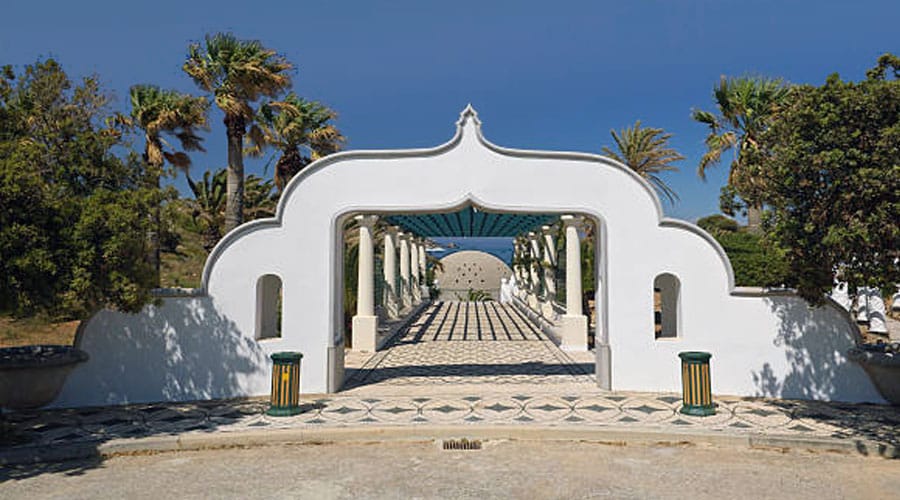
Film locations in Rhodes
Since the setting is cinematic, head to Anthony Quinn Beach, named after the fmous actor who starred in the movie ‘The Guns of Navarone’, scenes of which were filmed in Rhodes, and take your first dip of the day there. Witness the natural splendor of this well-hidden cove, where the rocks are covered in flowering shrubs and sheltered in calm turquoise waters.
In Kalathos, which is one of the beautiful beaches of Rhodes and usually has less wind, scenes of the film “Those Who Dare” with Dirk Bogart was shot. It is a sandy beach that usually does not gather hordes of tourists. The waters are crystal clear and always clean.
At the old Mandraki port where filmed scenes of the famous film Boy on the Dolphin with Sophia Loren while in the Old town was filmed scenes from Pascali’s island with Ben Gingsley.

Visit Lindos and Tsabika
You can visit Tsampika Monastery, a Byzantine Monastery or head towards Lindos to admire Cycladic architecture. For the Monastery of Tsambika you will have to climb about 300 steps which are also one of the characteristics of this church as it is said that the climb to the monastery is part of the blessing, for the prayer of the faithful. However, apart from the religious part, when you reach the top you will admire the incredible view. Just below is the beach of Tsambika, which is considered one of the most beautiful beaches of Rhodes.
As for the picturesque Lindos, it will fascinate you as it is a Cycladic surprise since it differs from the architecture of the Dodecanese. Today it is in fact one of the most picturesque parts of Rhodes.
Amphitheatrically built on the hill of the ancient Acropolis, the ruins of which are preserved, with its whitewashed houses and courtyards with mosaics, but also countless archaeological finds, it will inspire you for many photos for your Instagram. Don’t miss to visit the small closed port of Apostolos Pavlos, with its deep blue waters.
It is located at the back of Lindos, in a natural opening of the rocks and offers an amazing image that has enchanted many lovers for years and every year many couples from all over Europe choose this spot to have their wedding.
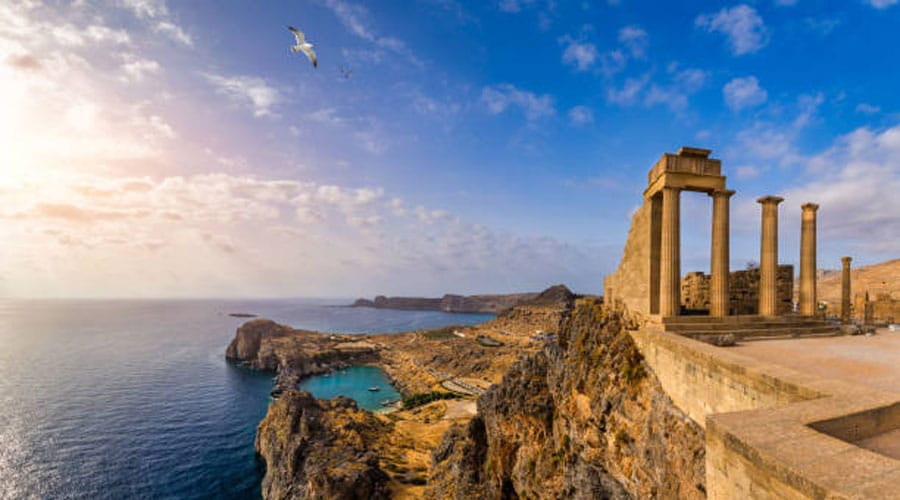
Rhodes towns and villages
With its 42 settlements, the island of Rhodes offers a taste of the history and tradition of the place. You must visit some of the most picturesque areas and villages, such as Lindos, Apollona, Eleousa, Embonas, Afandou, Archangelos, Kritinia, Lardou, Salakos, Monolithos, Kattavia, Vati.
Do not miss going to the village of Profitis Ilias for a walk and amazing routes in nature and to the historical hotel Elafos.
It is definitely worth passing through the Valley of Butterflies, one of the rare habitats, where it is the summer refuge of the Panaxia Quadripunctaria moth and is visited by thousands of visitors and researchers every year. The young butterflies every June leave each location on the island and travel by night to reach the valley.
Rhodes the capital of the island
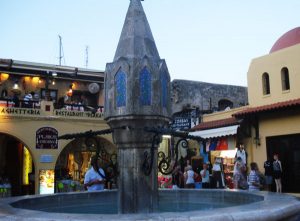
With so much to see within the city walls, the beaches tend to get overlooked. The main beach is just north of Mandraki harbour and stretches to the northern tip of the island.
Long ranks of sunbeds sit on the sand and shingle, linked by wooden duck boards and backed by a skyline of high rise hotels and the famous Rhodes’ casino.
The city beach is called Elli beach and the sandiest part lies front of the Mediterranean Hotel, although the sunbeds are crammed so tight you may not see a great deal of sand.
Rhodes beach is dominated by a staggered line of hotels that tower behind. More shingle than sand, the northern tip is little visited, just a swathe of stone curving around the headland.
This is where the Rhodes Aquarium, rather ominously called the Hydro-biological Institute sits, looking rather isolated, on a small hill.
On the north-west side is another, less attractive but popular beach, called Akti Miaouli. There are the usual tourist facilities from toilets to showers and plenty of watersports.
The north-west coast is exposed to the north winds and breakers can roll in when the wind gets up. The old walled city of Rodos lies just south of Mandraki harbour.
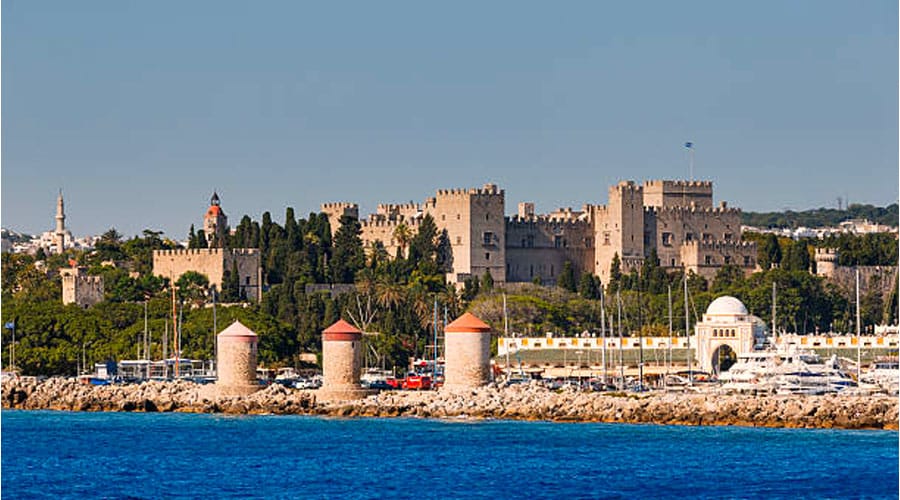
Lindos
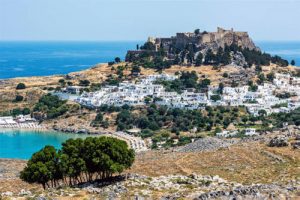
Above a long, curved fringed with golden sand sits an attractive hill village of sugar-cube houses, many with beautiful pebbled courtyards, and all linked by narrow, cobbled traffic free streets.Overlooking the bay is a well-preserved Crusader fortress enclosing an ancient acropolis where a temple to the Greek goddess Athena has been in situ since the 4th century BC.
Big crowds are a big problem for Lindos. As well as holiday visitors that pack the hillside apartments there are daily buses and boats bring in wave after wave of day trippers.
Visitors pack the tight alleyways and swamp shops and bars on their way up the the hill to the visit the castle. High rise hotels are banned and discos are confined to the outskirts but music bars and cafes blast out all-day music and the streets are so full that queues form just to walk from shop to shop.
In the traffic-free village, rooftop restaurants are everywhere but food is generally mediocre while the sandy beach crescent is packed with sunbeds and children play in the shallow waters of the enclosed bay.
Regular buses run both north and south with daily timetables posted in the main square, where there is also a small taxi rank.
There are around six buses daily to Rhodes City and there are taxi boats that leave the jetty in the morning and return mid-afternoon.
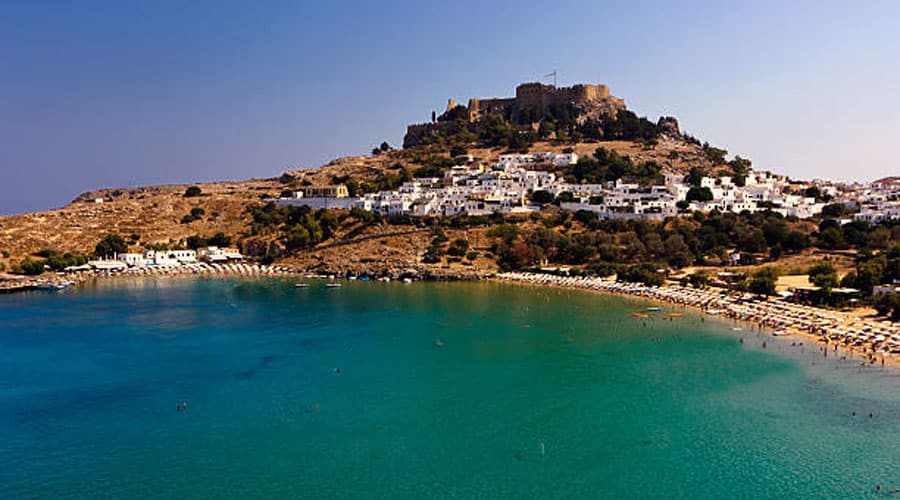
Trianda (Ialysos)
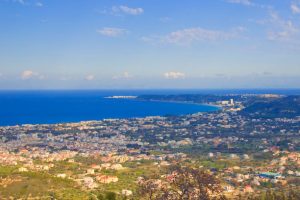
The Trianda beach strip runs for several kilometres and is home to the most fashionable five-star hotels on Rhodes, some concentrating on conference facilities and others on all-inclusive family holidays.
Trianda is also home to many smaller family hotels and apartment blocks surrounded by neon-lit music bars, international restaurants, roadside cafes and beach snack bars that meet almost everyone’s taste. Most are found on the long esplanade that runs behind the Trianda beach for almost all its length.
Trianda beach is not particularly good – mixture of sand and pebbles – but then it doesn’t need to be. Location is everything here, with a long sea front so near to the city and hotels offering their all-inclusive holidays with extravagant swimming pools and high end restaurants.
That said, there are plenty of facilities to be found on the Trianda beaches – sunbeds, showers and toilets are plentiful and there are a couple of watersports centres as well.
Trianda beach is north-facing so onshore winds can, even in high summer, bring heavy swells and crashing waves. The crowds tend to thin out the further you get from Rhodes City and it can get very much quieter when you reach the sand and pebble beach strip at the neighbouring beaches of Ialysos.
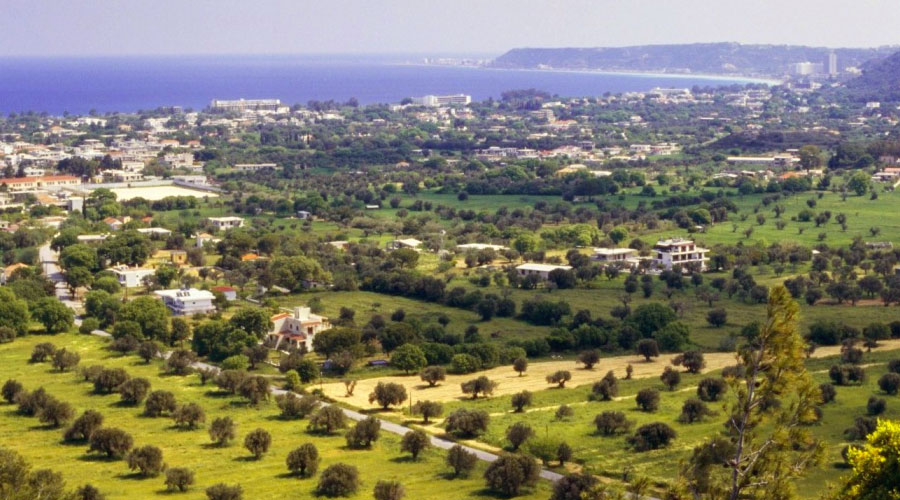
Faliraki
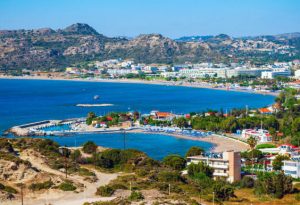
By day Faliraki beach is packed with sunbathers while at night the narrow streets throb to loud music, are lit by garish neon and heave with teenagers on the prowl for sex, drink or drugs.
Mountains of bad publicity followed a string of serious sexual assaults, forcing tour reps to axe bar-crawltours. Faliraki s still no place to be alone and female at night unless you are looking for trouble.
The beach at Faliraki is hard flat sand covered end-to-end by sunbeds and the sea is shallow. There are also showers and toilets.
There is no shortage of bars and tavernas although it’s mostly burgers and chips or coke and ice cream. Don’t expect traditional Greek food here unless you count the cheap Giros fast food kebabs.
Watersports run the full gamut, from banana rides to parasailing. There is even bungee jumping and sky surfing for the young.
The nearby Faliraki Water Park now boasts being the biggest in Europe and it’s packed with water slides, a massive wave pool, aqua gym and more, with a special area for children.
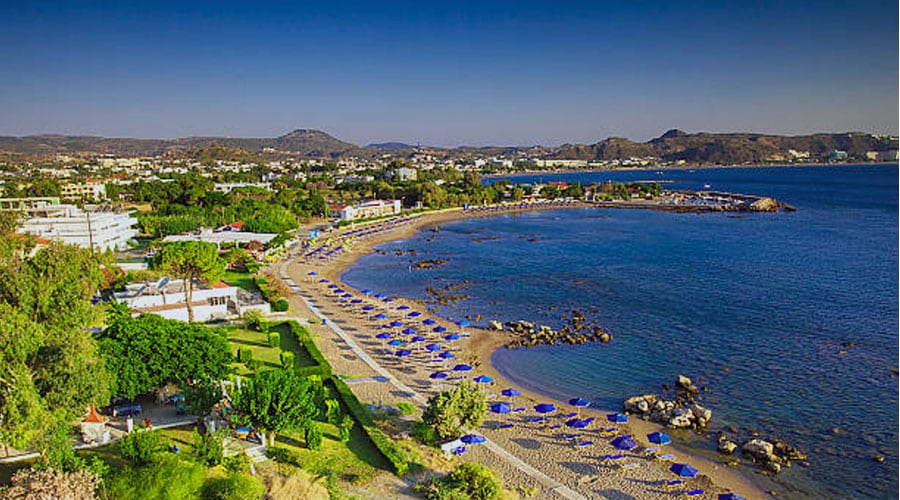
Afandou
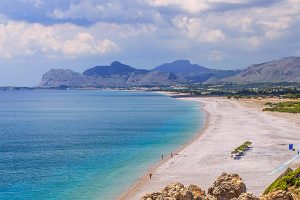
Afandou beach is located about 22 km from Rhodes Town and is found on the eastern coastal strip between the popular beach resorts of Faliraki and Kolymbia.The main road has a few more tavernas strung along it and there are many more cafes, music bars and tavernas, to be found in Afandou village centre.
There are a couple of tavernas and a beach cantina that opens in the high summer – not many such a long stretch but most of this huge beach is deserted for much of the year.
Afandou village is 2 km inland from the beach and the flat area between the two is bisected by the busy main road and alinks golf course – the only one on Rhodes. Tourists can cross one of the fairways to get to the sands or they can take the longer road around.
A road runs along the back of the beach for about much of its length so most parts of Afandou beach are easily accessible and the area is dotted with apartments and small hotels popular with British and German tour companies.
The most popular sections have sunbeds and some low-key watersports are on offer. The shoreline dips sharply into the sea where there are large rocks so many holidaymakers end up using Afandou as a base and head off elsewhere.
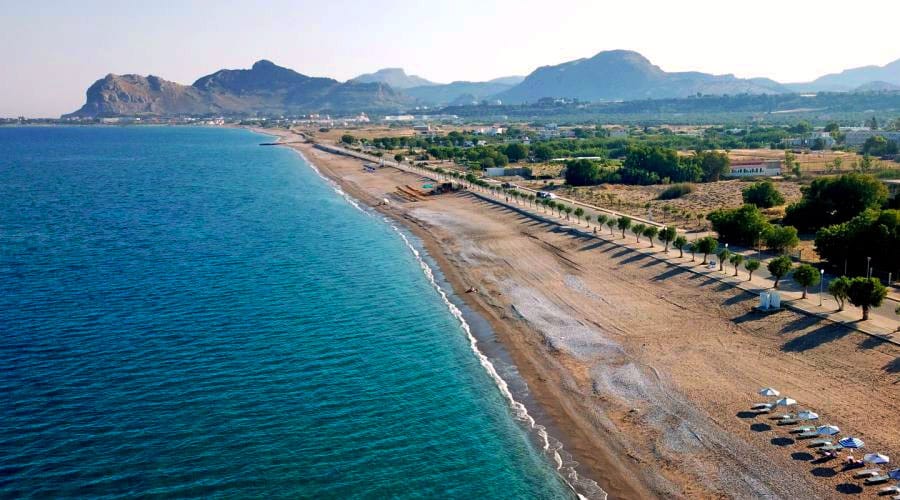
Haraki
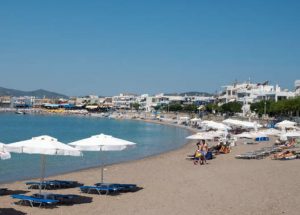
There are tavernas, cafes, bars and a few shops on the road behind the beach but, away from the beachfront, the village is not particularly inspiring with a few cement houses and apartments.
Impressive bare hills loom behind the bay, topped by the rather bleak ruins of Feraklos Castle, built by the Knights of St John and reached from a steep footpath where it commands great views of the coast.
The small harbour at one end of Haraki beach is the scene of much activity in the morning when the fishing boats leave and in the evening on their return.Otherwise, little happens in Haraki where entertainment is little more than lying on a sunbed and eating and drinking in the tavernas. The resort can get busy at weekends as it is popular with Greek families who come mainly to enjoy the excellent fish tavernas.
The sandy beach at Agathi is about 15 minutes away on foot and the hugely popular beach at Lindos is not far away. There is a cash point at the mini-market about fivekilometres out of Haraki and a daily bus travels to Lindos and to Rhodes Town.
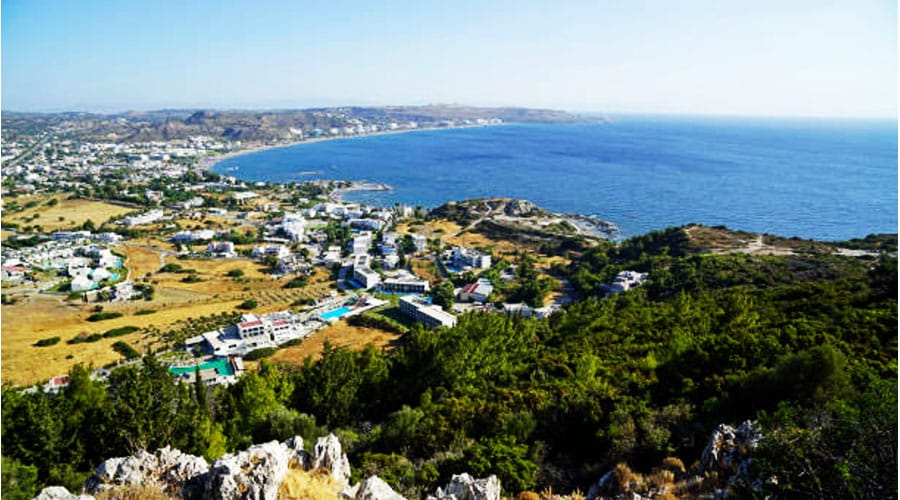
Kalathos
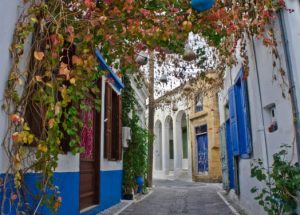
A large hotel complex sits in the middle of Kalathos beach and, although there are plenty sunbeds here, much of the beach to the north remains deserted even in the height of summer. At the far northern end of Kalathos beach is a derelict airstrip and control tower left over from World War II.
Visitors only go a few metres into the sea at Kalathos before it drops away sharply so it is not particularly good for families with children.
Kalathos village is about 800 metres from the beach, and there are regular bus services both north and south.The village also has several good tavernas and bars, shops and car rental firms. A cantina, some tavernas and a mini-market can be found on the road running along the back of Kalathos beach.
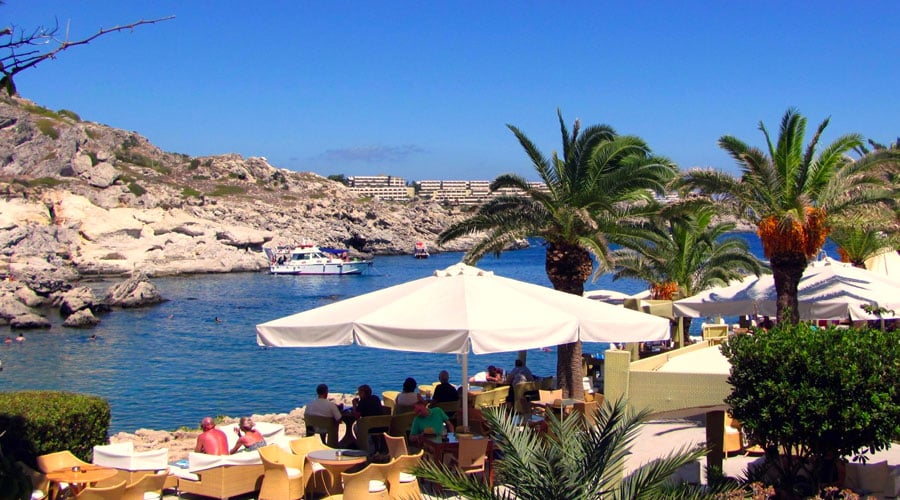
Ladiko
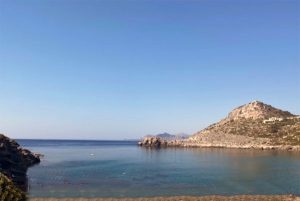
Once a remote and neglected beach is has become much more popular in recent years and now attracts a considerable number Greek and Italian holiday visitors. The nearby cliffs, dark and brooding, were used for location shots in the old classic war movie ‘The Guns of Navarone‘ and the bay is often referred to as ‘Anthony Quinn’ bay after the former film star bought a villa near here.
There is a small beach of fine sand and pebble set in a sheltered, horseshoe-shaped bay with an impressive rock promontory at the entrance and a few rocks scattered about.Sunbeds are now spread all around the shoreline and are even perched rather precariously on all the available rocks.
The steep cliffs that surround the bay can create lot of shade in the afternoons so keen sunbathers tend to get here early.There are no showers or toilets on the beach but a small cantina serves up the basics in the high summer. Ladiko beach is a popular port of call for day trip and round-island excursion boats, mainly because of the movie connection.
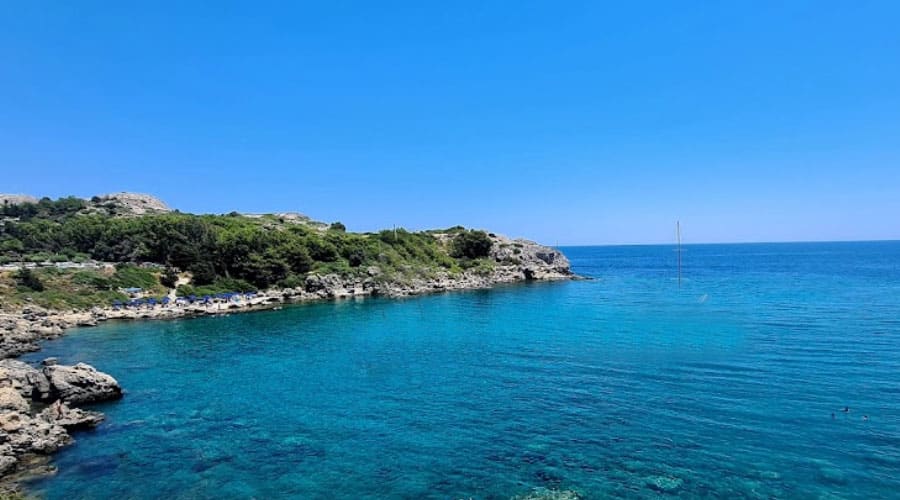
Lardos
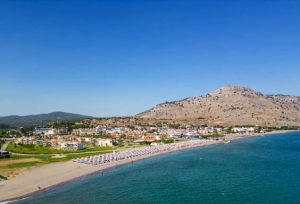
Lardos village is two kilometres inland from the beach and retains much old-time Greek atmosphere, with a tree-lined village square and a water fountain. This is where the locals sit in the evenings and watch the world pass by – the locals are strictly on Greek time.
The old village has plenty of facilities. There is a doctor, dentist, a pharmacy, hairdresser, cash point, car hire and shops of all kinds – even a bookmaker.
It’s a world away from the all-inclusive hotels of the beach resort on the coast which cater for more modern holiday tastes. Lardos beach is good, soft clean sand with some shingle and liberally covered with serried ranks of hotel sunbeds. Apart from in-hotel entertainment there is not much to do here, although the watersports are on offer. Decent footpaths lead from Lardos village to the beach and there are regular buses to Lindos and onto Rhodes City although buses can be crowded in high season and car hire is highly recommended if you want to get about.
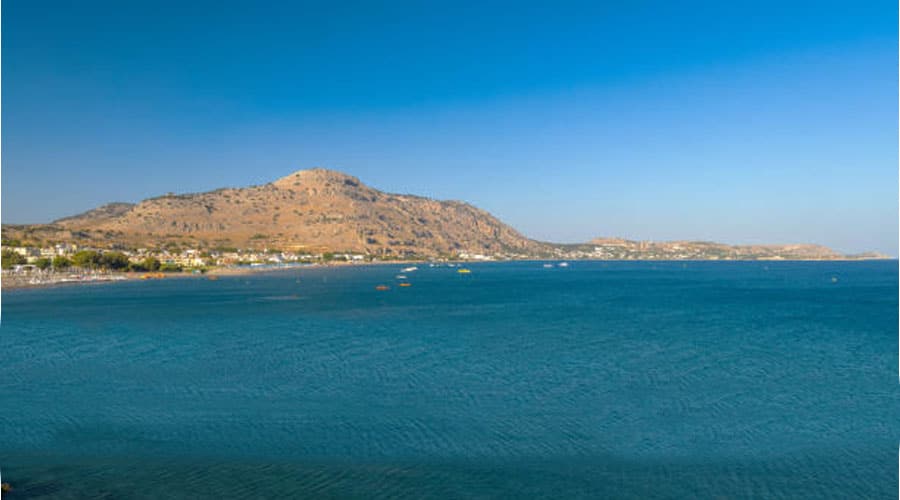
Pefkos
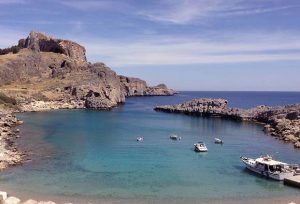
Buried in a pine forest (Pefkos translates as pine trees in Greek) the main resort straddles the main road well back from the beach area. Visitors will find a purpose-built tourist mall with about a dozen tavernas and bars, pubs as well as bakeries and gift shops.The wooded hilllside below the main street with paths through the woods lead to the Pefkos beach area.
The main sands are long and narrow strip of soft sand a couple of beach bars and some watersports. The sands narrow to the south-east with just enough room for a single row of sunbeds.There are daily buses to Lindos and to Rhodes City. There is plenty of car and bike hire and taxi boats that run along the coast to Lindos.
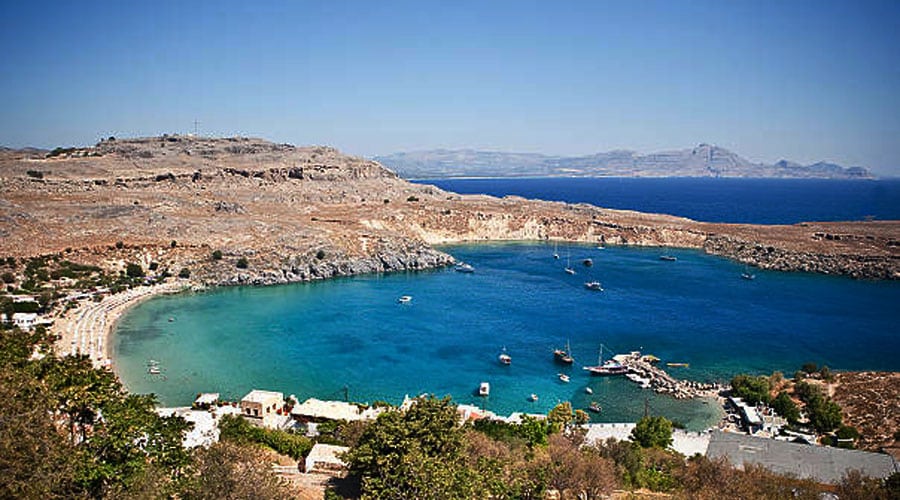
Beaches
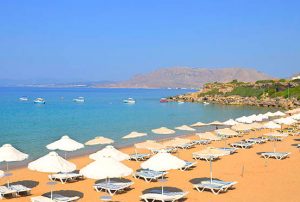
One of the most enticing aspects of Rhodes’ beaches is their sheer diversity. Along its approximately 220 miles of coastline, you’ll encounter pristine sandy stretches, hidden coves, rocky shores, and pebbled bays, all surrounded by the crystal-clear waters of the Aegean. The island’s beaches are scattered across its various regions, allowing you to embark on a coastal journey of exploration and relaxation.
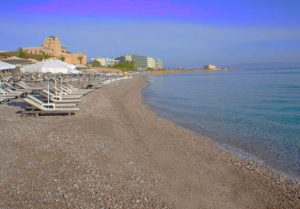
For travelers yearning for a more secluded experience, the southern coast of Rhodes beckons with pristine gems such as Tsambika Beach and Lindos Beach. Tsambika, with its soft, golden sands and shallow, turquoise waters, is ideal for families and sunbathers. Meanwhile, Lindos Beach, nestled beneath the ancient Acropolis of Lindos, combines the allure of history with the tranquility of a sun-soaked coastline.
Water sports enthusiasts will find their haven on beaches like Prasonisi, where strong winds create perfect conditions for windsurfing and kitesurfing. Here, the merging of the Aegean and Mediterranean seas adds a unique geographical touch to your aquatic adventures.
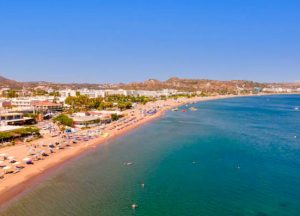
Away from the bustling resorts and urban centers, Rhodes conceals a host of hidden treasures for the intrepid explorer. The west coast, with its rugged cliffs and dramatic landscapes, is home to secluded beaches like Agios Pavlos, accessible by boat or a scenic hike, and perfect for a peaceful retrea
Where to stay
Rhodes offers a vast choice of holiday accommodation. Rhodes City has the best of the modern hotels. Many hotels in the medieval Rhodes Old Town are full of character while the suburbs provides a good supply of cheap rooms.
Faliraki has thousands of rooms but many hotels are block-booked by tour companies and it’s difficult to find a spare bed in the high season. The rest of Rhodes is dotted with small hotels and self-catering apartments.
The most luxurious hotels are found at Ixia. The Rodos Palace is the biggest five-star hotel in Greece and set in 30 acres of gardens.
There are many restored and converted Turkish and medieval buildings in the old town’s 14th century citadel. Those on a budget aim for the area between Sokratous and Omirou for cheap rooms and a youth hostel. There is no camping site on Rhodes. Ad hoc camping is illegal although you may get away with it on a remote beach for a night or two.
Lindos is the other big tourist draw and, thanks to a curb on hotel building, there are plenty of houses offering accommodation. In other resorts there are hotels, studios and rooms just about everywhere.
Nightlife
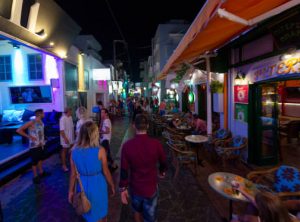
At the heart of Rhodes Town itself, a place where history and revelry merge seamlessly. Its narrow cobblestone streets are adorned with charming bars, cozy tavernas, and vibrant clubs. Here, you can sip on local wines or cocktails, listen to live music, and indulge in delectable Greek cuisine. The ambiance is enchanting, with ancient walls and medieval architecture providing a unique backdrop to your evening adventures.
Outside the Old Town, the modern city center of Rhodes Town offers a dynamic nightlife scene. The buzzing nightlife district of Orfanidou Street is lined with bars and clubs where you can dance the night away to the latest beats or classic tunes. Whether you’re into electronic dance music, jazz, or traditional Greek music, you’ll find a venue that suits your musical tastes.
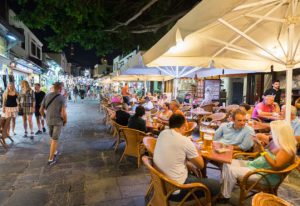
For a more laid-back and traditional experience, the island’s villages often host local festivals and celebrations, featuring live music, dance performances, and traditional feasts. These events provide an authentic glimpse into Greek culture and are a fantastic way to mingle with the locals.
Getting around Rhodes Greece
Road links are good but tend to deteriorate in the south. Buses serve the east and west coast cheaply and regularly but services peter out south of Lindos and a car or moped is essential here. A main road that runs south from Rhodes down the holiday coastal strip to Faliraki, Afandou and Lindos. Roads get rougher in the deep south and petrol stations are few.
Buses in Rhodes City, the suburbs and the west coast are operated by RODA (026300/024129) while the rest of the island is covered by KTEL. The tourist office in the capital publishes a schedule of routes and times each year. You can usually view it here.
Buses heading east, as far as Faliraki, leave from the East Side Bus Station on Plateia Rimini, while buses heading west, mainly to the north coast resorts and the airport, leave from the nearby West Side Bus Station on Averof.
Bus stops are marked by a sign, but drivers will stop pretty much anywhere on demand. Bus services south of Lindos are far fewer and car hire is preferred here. Car rental outfits can be found in most resorts. For the best deals it is probably best to book ahead online.
Rhodes City has plenty of taxis for hire. The biggest of many taxi stands is just outside the old town, on the harbour front at Plateia Rimini (22410 27666) or you can call a taxi (22410 69800) but there is a standard surcharge. Taxis on Rhodes are coloured dark blue with white roofs and you can get a list of taxi charges from any tourist information office.
When to go to Rhodes
The best time to visit Rhodes depends on your preferences for weather, crowds, and activities. Considering these factors, many visitors find that the shoulder seasons of spring and fall offer a good balance between favorable weather and fewer crowds. However, if you prefer the vibrancy of summer and want to engage in beach-related activities, then the summer months would be suitable for your visit.
Summer (June to August): This is the peak tourist season with hot and sunny weather. The temperatures can often exceed 30°C (86°F). The island is bustling with tourists during these months, and you can enjoy the beaches and various outdoor activities. However, it can be crowded, and accommodation prices may be higher.
Spring (April to June) and Fall (September to October): These shoulder seasons offer pleasant temperatures, with milder and more comfortable weather than the peak of summer. The crowds are generally thinner, and you can still enjoy outdoor activities without the intense heat. Spring, in particular, brings blooming flowers and green landscapes.
Winter (November to March): Rhodes has a mild winter compared to many other European destinations. While it’s not the best time for beach activities, the island is quieter, and you can explore historical sites without the summer crowds. Winter temperatures typically range from 8°C to 16°C (46°F to 61°F).
Tips for Traveling to Rhodes
When traveling to Rhodes, it’s essential to pack light and comfortable clothing suitable for the warm Mediterranean climate. Be sure to bring sunscreen, a hat, and sunglasses to protect yourself from the sun.
Rhodes has a well-connected public transportation system, including buses and taxis, making it easy to get around the island. Renting a car is also a popular option for those looking for more flexibility in exploring different parts of Rhodes.
To fully immerse yourself in local culture, don’t miss out on trying traditional dishes such as moussaka, souvlaki, and fresh seafood at local tavernas. Be open to new flavors and dining experiences during your stay.
Exploring off-the-beaten-path locations can lead to hidden gems and unique discoveries on the island. Don’t be afraid to venture beyond the typical tourist spots for an authentic Rhodes experience.
Remember to respect local customs and traditions while visiting Rhodes. Learning a few basic Greek phrases can go a long way in showing appreciation for the culture and connecting with locals during your trip.
How to get to Rhodes
By air
Diagoras International Airport Rhodes is 16 kilometres west of Rhodes City, near the resort of Kremasti. The airport has expanded in recent years and now handles more than three million visitors annually. In addition to regular domestic flights are charters to many countries. Ryanair has cheap flights from Liverpool and easyJet flies from Gatwick.
There are regular dometic flights to Athens and also to Thessaloniki by Sky Express which has up to four flights a week.
The airport has a single terminal with 13 check-in desks with eight gates and opens 24 hours a day. Despite recent improvements be prepared for long queues at peak times.
The airport has ATMs and a VIP lounge. There are various shops and a cafe, restaurant and bar. Passengers report that gates are hard to find and baggage handling can be seriously slow. Short term and long term parking is outside and there are 30 buses daily to Rhodes City, a journey time of 40 minutes. The bus station is about 300 metres from the terminal.
There are usually plenty of taxis around and car hire companies have offices. The airport is located on a dual carriageway and it’s clearly signposted. There is no airport hotel at Diagoras Airport.
By ferry
Rhodes is a major port for ferry services and boat trips and there is no shortage of route to other islands, to the Greek mainland and to Turkey.
Rhodes Ferry Port is found at the north-eastern end of the old town. Blue Star Ferries run daily services from Piraeus (Athens) but journey times are long – about 16 hours. Some travel direct to Rhodes, others call in at Leros, Patmos, Kalymnos and Kos.
Hellenic Seaways calls at Paros and Kos; ANEK Lines has a car ferry to Milos, Santorini, Crete and Karpathos, another that goes via Patmos, Lipsi, Leros, Kalymnos, Kos and Symi and yet another that calls at Santorini, Anafi, Kassos, Karpathos, Diafni and Chalki.
Many islands in the Dodecanese chain are connected by the Dodekanese Seaways catamaran service from Rhodes to Kos, Kalymnos, Leros and Patmos and Lipsi.Daily catamaran and car ferry sailings to Mamaris, Turkey, are very popular. Marmaris Ferry takes cars and motorbikes and sails on Tuesday and Wednesday while Alaturka Ferries has daily sailing by catamaran and hydrofoil to Marmaris and to Fethiye and Yesil Marmaris Lines runs routes to Marmaris and Bodrum.
The Bodrum Express runs daily excursions to Bodrum, via Symi, while E-Ferry has started fast passenger services to Bodrum, Marmaris and Symi for individual passengers or small groups. Daily boat trips and excursion are on offer from Mandraki harbour. There are also daily boats to Symi, calling in at Panormitis Monastery.
